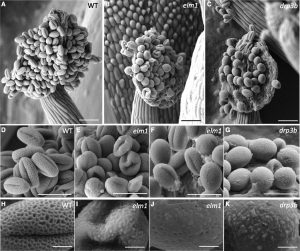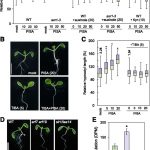A Role for Mitochondrial Fission in Pollen Growth
The tapetum is the innermost layer of the anther and encloses the locule wherein pollen develops. In addition to supplying nutrients for pollen growth, the tapetum synthesizes and transfers pollen outer wall precursors for the formation of the pollen outer wall. To synthesize, secrete, and transfer materials for pollen growth, the tapetum requires an abundant supply of energy. Unfortunately, the manners and mechanisms by which tapetal mitochondrial morphology, volume, number, and distribution, are altered during pollen development are poorly understood. In general, the mitochondrial networks of cells are  regulated by fusion and fission. Mitochondrial fission occurs frequently in plant cells, but its biological significance is poorly understood because mutants specifically impaired in mitochondrial fission do not show obvious defects in vegetative growth. In plants, several proteins are involved in mitochondrial fission, particularly dynamin and dynamin-related proteins. Chen et al. (10.1104/pp.19.00183) demonstrate that the production of viable pollen in Arabidopsis is reduced in mutants lacking one of the three main proteins involved in mitochondrial fission, DYNAMIN-RELATED PROTEIN3A (DRP3A)/Arabidopsis DYNAMIN-LIKE PROTEIN2A, DRP3B, and ELONGATED MITOCHONDRIA1 (ELM1). In drp3b and elm1, young microspores contained an abnormal number of nuclei, and mature pollen had aberrant accumulation of lipids in their coat and an irregular pollen outer wall. Defective mitochondrial fission in the elm1 and drp3b mutants caused changes in mitochondrial status, including mitochondrial elongation, abnormal mitochondrial ultrastructure, a decrease in cross-sectional area, and a slight alteration of mitochondrial distribution, as well as a large reduction in mitochondrial density.
regulated by fusion and fission. Mitochondrial fission occurs frequently in plant cells, but its biological significance is poorly understood because mutants specifically impaired in mitochondrial fission do not show obvious defects in vegetative growth. In plants, several proteins are involved in mitochondrial fission, particularly dynamin and dynamin-related proteins. Chen et al. (10.1104/pp.19.00183) demonstrate that the production of viable pollen in Arabidopsis is reduced in mutants lacking one of the three main proteins involved in mitochondrial fission, DYNAMIN-RELATED PROTEIN3A (DRP3A)/Arabidopsis DYNAMIN-LIKE PROTEIN2A, DRP3B, and ELONGATED MITOCHONDRIA1 (ELM1). In drp3b and elm1, young microspores contained an abnormal number of nuclei, and mature pollen had aberrant accumulation of lipids in their coat and an irregular pollen outer wall. Defective mitochondrial fission in the elm1 and drp3b mutants caused changes in mitochondrial status, including mitochondrial elongation, abnormal mitochondrial ultrastructure, a decrease in cross-sectional area, and a slight alteration of mitochondrial distribution, as well as a large reduction in mitochondrial density.



